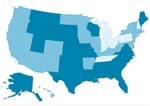health
Doctors urged to educate patients about sodium consumption
■ Ten food types, including bread and poultry, account for 44% of sodium intake, a study says.
- WITH THIS STORY:
- » Most common sources of dietary sodium
Primary care physicians should talk to patients about ways to lower their sodium intake by about a quarter teaspoon of salt each day, says a Centers for Disease Control and Prevention official.
Such a reduction would prevent thousands of deaths from cardiovascular disease, hypertension and stroke a year and save billions in health care dollars, said Mary E. Cogswell, DrPH, a senior scientist in the Division for Heart Disease and Stroke Prevention in the CDC's National Center for Chronic Disease Prevention and Health Promotion.
To achieve that goal, she encourages doctors to educate patients on the amount of sodium they need each day and the importance of checking sodium content on nutrition labels. She also recommends that physicians talk to patients about items that have high sodium levels.
Ten types of food account for 44% of the dietary sodium that Americans consume each day, according to a study published in the Feb. 10 issue of the CDC's Morbidity and Mortality Weekly Report. Cogswell co-wrote the study.
"It's surprising to most people that the top food sources of sodium intake are those we eat most commonly, including bread, rolls and poultry," she said. "Sodium consumption is directly related to hypertension, which is a primary risk factor for heart disease, stroke and other cardiovascular diseases. That's why it's really important to identify the food sources."
In 2008, hypertension was reported as a primary or contributing cause of about 348,000 U.S. deaths, the MMWR report said. Thirty-one percent of U.S. adults have hypertension, and fewer than half of those adults have their blood pressure levels under control, the study said.
Researchers examined data on 7,227 people age 2 and older who participated in the 2007-08 What We Eat in America, National Health and Nutrition Examination Survey. Participants completed two 24-hour dietary recalls in which they were surveyed on what they ate and how much of it they consumed in the past day.
Researchers found that mean daily sodium consumption among participants was 3,266 milligrams, well above the suggested levels set by the U.S. Dietary Guidelines, according to the report (link).
The federal guidelines recommend that Americans consume no more than 2,300 milligrams of sodium per day. High-risk groups, including adults 51 and older, blacks and anyone with diabetes, chronic kidney disease and hypertension, should consume no more than 1,500 milligrams a day.
Bread and rolls were responsible for the highest percentage of daily sodium intake (7%) followed by cold cuts/cured meats, pizza, and fresh and processed poultry (all 5%). Four percent of daily sodium consumption came from each of the following items: soups, sandwiches and cheese. Other common sources of sodium included pasta mixed dishes, such as spaghetti with meat sauce; meat-mixed dishes, including meatloaf with tomato sauce; and chips and pretzels (3% each).
Cogswell said some of the items, such as bread, do not have high sodium levels when eaten in moderation. But she said the study indicates that Americans tend to consume a lot of bread.
Data show that 65% of sodium comes from food sold in stores and 25% from meals purchased in restaurants. The study authors encourage doctors to talk to their patients about eating more fresh or frozen fruits and vegetables without sauce.












